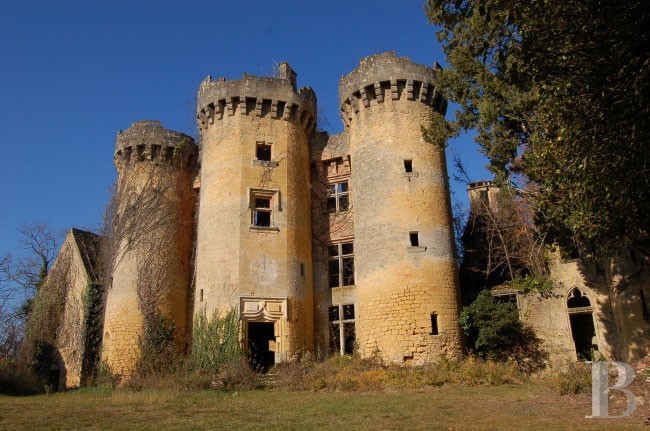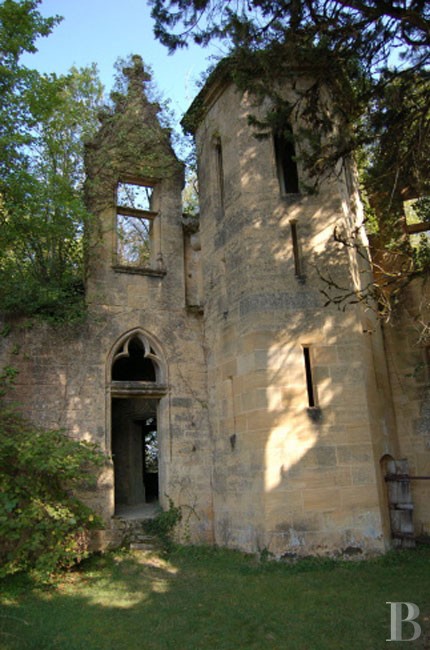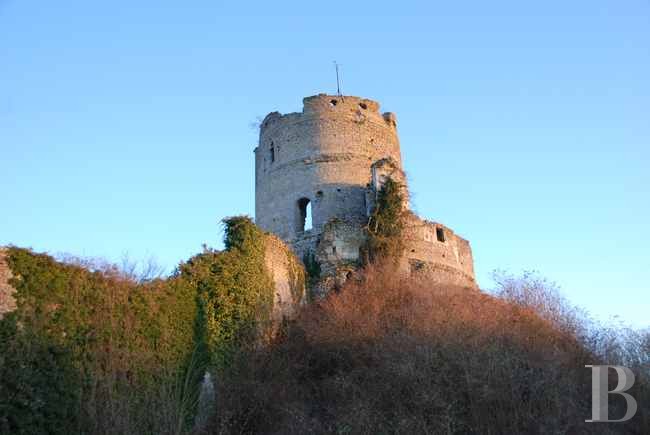While some people might be interested in castles that have been kept up-to-date and in good condition, others may want to buy a ruined medieval castle, which could serve as a treasure-trove for archaeologists, or for those interested in examing a medieval structure that has been unchanged for hundreds of years (with the exception of damage done from centuries of weather and the encroach of nature).
We are featuring two medieval ruins in France which are currently for sale through Patrice Besse, a French real-estate firm that specializes in Castles and historic buildings.
Périgord

Considered to be the “most beautiful ruin in the Périgord,” these remains of a castle dating from the 13th and 14th centuries keeps watch over its predominantly wooded fiefdom of approximately 91 acres.
The impressive architectural quality of this monument, defended by double walls, lives on despite the ravages of time and history: miniature castle entrance gates, towers, keep, main building, stables, barn, service quarters, storage tank and dovecote in the oldest part; neo-gothic wing with several living rooms and a chapel in the part annexed during the 19th century.
 Nature has reasserted itself throughout but almost seems to magnify the outstanding solidly preserved features: crenelles, wall walk, machicolation, cross-ribbed vault, spiral stairways, gothic windows, flamboyant doors, monumental fireplace, ornamental mouldings, mullioned windows, cellars, tailrace channel, fountain, etc.
Nature has reasserted itself throughout but almost seems to magnify the outstanding solidly preserved features: crenelles, wall walk, machicolation, cross-ribbed vault, spiral stairways, gothic windows, flamboyant doors, monumental fireplace, ornamental mouldings, mullioned windows, cellars, tailrace channel, fountain, etc.
On a lower level, a well-maintained leisure property makes it possible to take advantage of a wonderful setting enhanced by the unequalled pleasure of an unchanging past: a large traditional Périgord-style house with its adjoining barn set at right angles, caretakers’ cottage, parklands, swimming pool, tennis court and small stables. Further away, a mill with its barn, a borie in the garden and a mill race close to a 1st category fish-filled stream. Opposite, a guest house and its outbuilding in the middle of the woods with an independent access.
Click here for more photos and details.
Epte valley – Sold!
Located 44 miles from Paris, and 14 miles from Les Andelys and Giverny, this ruined Norman castle was recently sold.

The construction as it exists today, is of a motte and enclosing wall fortifications and probably dates from the eleventh or twelfth centuries. It comprises a central tower, an inner and outer bailey and various other buildings.
The central tower stands astride the outer enclosing wall, defending the most vulnerable part of the fortifications. Only the northern half of the castle’s main feature is left standing; the other having been destroyed in 1647. Cylindrical in shape, it is 59’ high with an outside diameter of 37.7’ and is essentially made of limestone rubble and flint.
A secondary enclosing trapezoidal wall contains the inner bailey, the intermediary area between the outer bailey and the central tower. An early 20th century building, facing the outer bailey, adjoins the north curtain wall. The outer bailey of approx. 2.47 acres currently comprises more recent buildings used for farming purposes, a house as well as a dovecote. It is closed by the outer enclosing wall and accessed via two gate towers.
The gate towers that are integrated into the outer enclosing wall are built in the same style. In a U-shape as in Gisors, they open on to the outer bailey by means of a triangular-arched passageway. The oval-shaped, outer enclosing wall crowns the top of the moat scarp. Beyond these limits, a dry moat makes access to the outer bailey difficult.
The square, U-shaped, south tower, the last means of defence before the central tower, is 3 storeys high. 2 openings for a construction in 2 sections. The annex buildings: farm buildings and the ruins of 2 houses are situated along the north section of the outer enclosing wall. Later than the rest of the property, they can be dated from the 17th and 18th centuries.
Adjoining the secondary enclosing wall is a house that was still lived in until a short while ago by a farmer. It faces the outer bailey, in the middle of which is a recently restored dovecote whose origins probably date back to between the 13th and 15th centuries.
While some people might be interested in castles that have been kept up-to-date and in good condition, others may want to buy a ruined medieval castle, which could serve as a treasure-trove for archaeologists, or for those interested in examing a medieval structure that has been unchanged for hundreds of years (with the exception of damage done from centuries of weather and the encroach of nature).
We are featuring two medieval ruins in France which are currently for sale through Patrice Besse, a French real-estate firm that specializes in Castles and historic buildings.
Périgord
Considered to be the “most beautiful ruin in the Périgord,” these remains of a castle dating from the 13th and 14th centuries keeps watch over its predominantly wooded fiefdom of approximately 91 acres.
The impressive architectural quality of this monument, defended by double walls, lives on despite the ravages of time and history: miniature castle entrance gates, towers, keep, main building, stables, barn, service quarters, storage tank and dovecote in the oldest part; neo-gothic wing with several living rooms and a chapel in the part annexed during the 19th century.
On a lower level, a well-maintained leisure property makes it possible to take advantage of a wonderful setting enhanced by the unequalled pleasure of an unchanging past: a large traditional Périgord-style house with its adjoining barn set at right angles, caretakers’ cottage, parklands, swimming pool, tennis court and small stables. Further away, a mill with its barn, a borie in the garden and a mill race close to a 1st category fish-filled stream. Opposite, a guest house and its outbuilding in the middle of the woods with an independent access.
Click here for more photos and details.
Epte valley – Sold!
Located 44 miles from Paris, and 14 miles from Les Andelys and Giverny, this ruined Norman castle was recently sold.
The construction as it exists today, is of a motte and enclosing wall fortifications and probably dates from the eleventh or twelfth centuries. It comprises a central tower, an inner and outer bailey and various other buildings.
The central tower stands astride the outer enclosing wall, defending the most vulnerable part of the fortifications. Only the northern half of the castle’s main feature is left standing; the other having been destroyed in 1647. Cylindrical in shape, it is 59’ high with an outside diameter of 37.7’ and is essentially made of limestone rubble and flint.
A secondary enclosing trapezoidal wall contains the inner bailey, the intermediary area between the outer bailey and the central tower. An early 20th century building, facing the outer bailey, adjoins the north curtain wall. The outer bailey of approx. 2.47 acres currently comprises more recent buildings used for farming purposes, a house as well as a dovecote. It is closed by the outer enclosing wall and accessed via two gate towers.
The gate towers that are integrated into the outer enclosing wall are built in the same style. In a U-shape as in Gisors, they open on to the outer bailey by means of a triangular-arched passageway. The oval-shaped, outer enclosing wall crowns the top of the moat scarp. Beyond these limits, a dry moat makes access to the outer bailey difficult.
The square, U-shaped, south tower, the last means of defence before the central tower, is 3 storeys high. 2 openings for a construction in 2 sections. The annex buildings: farm buildings and the ruins of 2 houses are situated along the north section of the outer enclosing wall. Later than the rest of the property, they can be dated from the 17th and 18th centuries.
Adjoining the secondary enclosing wall is a house that was still lived in until a short while ago by a farmer. It faces the outer bailey, in the middle of which is a recently restored dovecote whose origins probably date back to between the 13th and 15th centuries.
Related Posts
Subscribe to Medievalverse